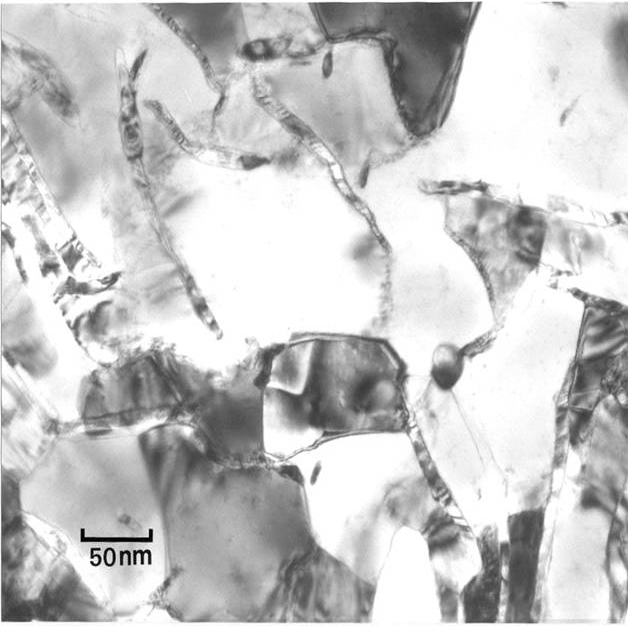Next: 4.2 Simulational model Up: 4. Magnetization reversal in Previous: 4. Magnetization reversal in Contents
The magnetic characterization of samples has been performed by the
group of A. Hernando, J.M. González in the Instituto de
Magnetismo Aplicado (IMA). The magnetization decrease with temperature
of the nanoribbons deviated from the typical ![]() bulk behavior, as observed by P. Crespo et
al. [Crespo 04]. For small
enough cross section
dimensions this dependence becomes linear as shown in Fig. 4.2. It appears that the reduced size of
the nanoribbons modifies the dispersion relation of the magnetic
excitations (magnons). The magnons with wave length longer than the
ribbon size can not propagate. From a model describing
the magnons in the nanoribbons the value of
bulk behavior, as observed by P. Crespo et
al. [Crespo 04]. For small
enough cross section
dimensions this dependence becomes linear as shown in Fig. 4.2. It appears that the reduced size of
the nanoribbons modifies the dispersion relation of the magnetic
excitations (magnons). The magnons with wave length longer than the
ribbon size can not propagate. From a model describing
the magnons in the nanoribbons the value of ![]() was obtained as
an indirect estimate of the average particle length for the sample
in which the average cross section was
was obtained as
an indirect estimate of the average particle length for the sample
in which the average cross section was ![]() [Crespo 04].
Furthermore, the variation of the ribbon cross section modifies the
shape anisotropy resulting from its elongated shape. Due to the large
aspect ratio appearing in some samples, this anisotropy can surpass the
bcc Fe magnetocrystalline anisotropy (intrinsic parameter). Therefore,
the magnetization reversal mechanism and the coercivity will be
affected by the change of the particle dimension as observed
experimentally. The hysteresis loops were obtained by vibrating sample
magnetometer, cycling between
[Crespo 04].
Furthermore, the variation of the ribbon cross section modifies the
shape anisotropy resulting from its elongated shape. Due to the large
aspect ratio appearing in some samples, this anisotropy can surpass the
bcc Fe magnetocrystalline anisotropy (intrinsic parameter). Therefore,
the magnetization reversal mechanism and the coercivity will be
affected by the change of the particle dimension as observed
experimentally. The hysteresis loops were obtained by vibrating sample
magnetometer, cycling between ![]() and
and ![]() a magnetic field, which was applied along
the long axis of the wire-shaped samples (the cold work direction
coinciding with the Fe particles axes and the crystallographic (110)
directions). In Fig. 4.3 the
coercive field is presented as a function of the average width of the
particles.
a magnetic field, which was applied along
the long axis of the wire-shaped samples (the cold work direction
coinciding with the Fe particles axes and the crystallographic (110)
directions). In Fig. 4.3 the
coercive field is presented as a function of the average width of the
particles.

 |
![\includegraphics[height=6.5cm]{Capitulo4/Graficas4/mtemperature.eps}](img641.gif)
|
The present chapter is devoted to the micromagnetic simulations performed to analyze the magnetization reversal process taking place in those highly textured Fe nanoparticles. Our aim is to find the correspondence between experimental results and those obtained from simulations in which the local properties are systematically varied in plausible ranges. This stimulated us to attempt to go beyond traditional micromagnetics, trying to include into consideration several major contributions that are not easy to estimate, arising from the nanostructuration and fabrication process, for example residual stress or imperfect shapes, or the broken symmetry at the nanoribbon surface. In this chapter we consider, in addition to the macroscopic values of exchange, magnetization and magnetocrystalline anisotropy, different values of surface magnetocrystalline and magnetoelastic anisotropies, and the occurrence of different textures on the crystalline orientation of the nanoribbons. We also study the thermal reversal process and its possible influence on the coercivity.
![\includegraphics[height=7.cm]{Capitulo4/Graficas4/experimentalcoerc.eps}](img642.gif)
|
2008-04-04